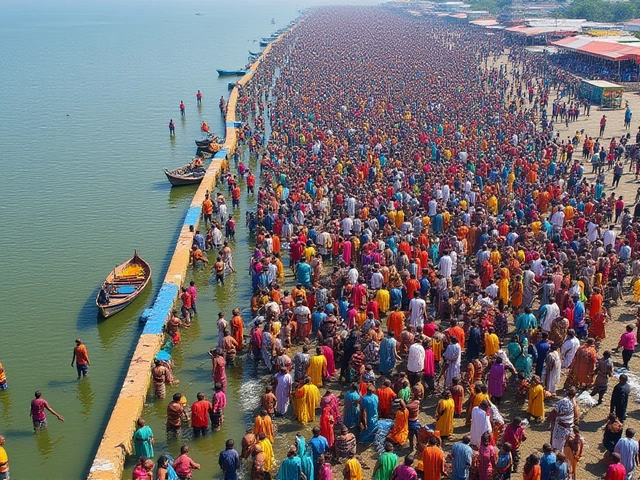When Rahmanullah Gurbaz walked out to open the innings for Afghanistan at Arnos Vale Ground on June 24, 2024, nobody could have guessed the historic ripple it would create.
In the ICC Men's T20 World Cup 2024West Indies, Afghanistan posted 115/5 in their full 20 overs, with Gurbaz smashing 43 and a late blitz from Rashid Khan (19* off 10 balls). Bangladesh, fielding a side that had never looked more desperate, were bundled out for 105, despite a dazzling 54* from Litton Das. The DLS method, invoked after several rain showers, ultimately handed Afghanistan an eight‑run win and a maiden semi‑final berth.
The Match in a Nutshell
Afghanistan won the toss, elected to bat, and set a modest target that proved just enough. The pitch was a flat, low‑bounce surface, and the temperature hovered around 26°C, making run‑scoring easier but also rewarding disciplined bowling. The turning point came in the second innings when Naveen-ul-Haq and Rishad Khan each cracked three wickets, while Rashid Khan ripped out four for 23, choking Bangladesh’s chase under pressure.
How Afghanistan Pulled Off the Win
Gurbaz’s 43 came off 31 balls, a blend of textbook drives and a few daring lofted shots that kept the scoreboard ticking. Behind him, captain Hashmatullah Shahidi added a steady 15, anchoring the innings while the lower order accelerated. Rashid Khan’s cameo, three fours and a six, pushed the total past the DLS par after the first rain interruption.
Afghanistan’s bowlers were ruthless: Rashid’s 4/23 came in a spell that saw him clean‑bowling the top order, including a key wicket of Bangladesh’s opening batsman in the 7th over. Naveen‑ul‑Haq’s consistency (4/26) and Rishad’s knack for breaking partnerships (3/26) meant Bangladesh never settled. Their combined economy of 5.5 runs per over was impressive given the rain‑affected, shifting DLS target.
Bangladesh’s Fight and the DLS Drama
Litton Das, the Bangladesh keeper‑batter, tried to steer his side home with a brilliant half‑century, hitting 54* off 38 balls – his highest in the tournament, eclipsing his previous best of 36. Yet every boundary was met with a wicket, as the Afghan attack kept the pressure relentless.
The DLS calculations added a layer of suspense. After the first rain delay, Bangladesh briefly crept above the par score, prompting cheers from the stands. A second interruption reset the target, and Afghanistan’s early wickets pushed Bangladesh back below the required run‑rate. In the end, the Indians‑style “cat‑and‑mouse” chase ended with Naveen‑ul‑Haq dismissing the last man, sealing the victory.

Reactions from Players and Officials
“It feels unreal,” Rashid Khan said in the post‑match interview, his voice barely audible over the roar of the Afghan bench. “We knew the rain could change everything, but our plan was simple – take wickets, keep the pressure.”
Litton Das, though disappointed, praised the Afghan effort: “They bowled incredibly well, especially in the death overs. We gave it our all, but the DLS made it a tough finish.”
On‑field umpire Langton Rusere noted the professionalism of both sides despite the interruptions, while match referee Sir Richardson praised the conduct of the Afghanistan camp, highlighting their respect for the spirit of the game.
What the Victory Means for Afghan Cricket
This win is more than a scoreboard line; it’s a seismic shift for a nation that has battled conflict for decades. Reaching the semi‑finals of any senior ICC World Cup—be it T20, ODI, or Test—has never happened before for Afghanistan. The triumph marks a coming‑of‑age moment, signalling that the side has moved from associate status to a genuine contender on the world stage.
Experts are already talking about the ripple effects: increased funding from the ICC, a surge in grassroots participation, and a boost to the nation’s morale back home. Former captain Mohammad Nabi reflected on the journey, “From playing on sand pitches to dancing in the semi‑finals—this is a story that will inspire a generation.”

Key Facts
- Afghanistan 115/5 (20 overs) – Gurbaz 43, Rashid Khan 19*.
- Bangladesh 105 all out (18.3 overs) – Litton Das 54*.
- Bowling highlights: Rashid Khan 4/23, Naveen‑ul‑Haq 4/26, Rishad Khan 3/26.
- Match decided by DLS method after two rain interruptions.
- Afghanistan advances to their first senior‑level ICC World Cup semi‑final.
Frequently Asked Questions
How does Afghanistan’s win affect their chances in the semi‑final?
The victory secures Afghanistan a spot in the semi‑final, where they will face either India or England depending on the outcome of Group 2 matches. A win would guarantee a final berth, a feat never achieved by the nation before.
What role did the DLS method play in the final result?
Two rain delays forced the officials to invoke the Duckworth‑Lewis‑Stern calculation twice. The method adjusted Bangladesh’s target upwards after each interruption, turning a brief lead into a deficit that Afghanistan’s bowlers capitalised on.
Who were the standout performers for Afghanistan?
Besides Gurbaz’s 43, Rashid Khan’s 4/23 was decisive, and Naveen‑ul‑Haq’s 4/26, coupled with Rishad Khan’s 3/26, dismantled Bangladesh’s chase. Their combined economy and wicket‑taking put Afghanistan in control.
What does this win mean for cricket back in Afghanistan?
It provides a massive morale boost, likely attracting more sponsors and fostering youth participation. The ICC may allocate additional development funds, and the achievement could inspire infrastructure upgrades across the country.
When and where will the semi‑final be played?
The semi‑final is scheduled for June 26‑27, 2024, at the Kensington Oval in Bridgetown, Barbados. The exact date will depend on the final Group 2 fixture between India and England.





